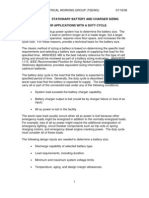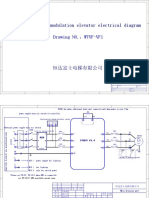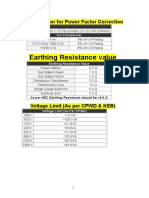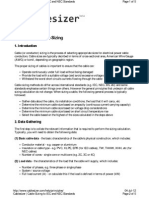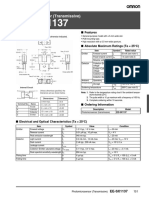Cablesizer Cable Sizing To IEC and NEC Standards PDF
Cablesizer Cable Sizing To IEC and NEC Standards PDF
Uploaded by
tobyCopyright:
Available Formats
Cablesizer Cable Sizing To IEC and NEC Standards PDF
Cablesizer Cable Sizing To IEC and NEC Standards PDF
Uploaded by
tobyOriginal Title
Copyright
Available Formats
Share this document
Did you find this document useful?
Is this content inappropriate?
Copyright:
Available Formats
Cablesizer Cable Sizing To IEC and NEC Standards PDF
Cablesizer Cable Sizing To IEC and NEC Standards PDF
Uploaded by
tobyCopyright:
Available Formats
Cablesizer | Cable Sizing to IEC and NEC Standards
Help
New Cable
Principles of Cable Sizing
1. Introduction
Cable (or conductor) sizing is the process of selecting appropriate sizes for electrical power cable
conductors. Cable sizes are typically decribed in terms of cross-sectional area, American Wire Gauge
(AWG) or kcmil, depending on geographic region.
The proper sizing of cables is important to ensure that the cable can:
Operate continuously under full load without being damaged
Provide the load with a suitable voltage (and avoid excessive voltage drops)
Withstand the worst short circuits currents flowing through the cable
Cable sizing methods do differ across international standards (e.g. IEC, NEC, BS, etc) and some standards
emphasise certain things over others. However the general principles that underpin all cable sizing
calculation do not change. When sizing a cable, the following general process is typically followed:
Gather data about the cable, its installation conditions, the load that it will carry, etc
Determine the minimum cable size based on ampacity (continuous current carrying capacity)
Determine the minimum cable size based on voltage drop considerations
Determine the minimum cable size based on short circuit temperature rise
Select the cable based on the highest of the sizes calculated in the steps above
2. Data Gathering
The first step is to collate the relevant information that is required to perform the sizing calculation.
Typically, you will need to obtain the following data:
(1) Basic cable data - the basic characteristics of the cable's physical construction, which includes:
Conductor material - e.g. copper or aluminium
Insulation or cable type - e.g. PVC, XLPE, EPR (for IEC cables), TW, THHW, XHH, etc (for NEC cables)
Number of cores - single core or multicore (e.g. 2C, 3C or 4C)
(2) Load data - the characteristics of the load that the cable will supply, which includes:
Number of phases, e.g. three phase or single phase
System / source voltage
Full load current (A) - or calculate this if the load is defined in terms of power (kW)
Full load power factor (pu)
Distance / length of cable run from source to load - this length should be as close as possible to the
actual route of the cable and include enough contingency for vertical drops / rises and termination of
the cable tails
(3) Cable installation - how the cable will be installed, which includes:
http://www.cablesizer.com/help/principles/[3/13/2013 11:24:25 AM]
Cablesizer | Cable Sizing to IEC and NEC Standards
Installation method - e.g. cable tray / ladder, in conduit / raceways, against a wall, in air, directly
buried, etc
Ambient or soil temperature at the installation site
Cable grouping, i.e. the number of other cables that are bunched together or installed in the same
area
Cable spacing, i.e. whether cables are installed touching or spaced
Soil thermal resistivity (for underground cables)
For single core three-phase cables, are the cables installed in trefoil or laid flat?
3. Cable Selection Based on Ampacity
Current flowing through a cable generates heat through the resistive losses in the conductors, dielectric
losses through the insulation and resistive losses from current flowing through any cable screens / shields
and armouring.
A cable's constituent parts (particularly the insulation) must be capable of withstanding the temperature
rise and heat emanating from the cable. The ampacity of a cable is the maximum current that can flow
continuously through a cable without damaging the insulation. It is sometimes also referred to as the
continuous current rating or current carrying capacity of a cable.
Cables with larger conductor cross-sectional areas (i.e. more copper or aluminium) have lower resistive
losses and are able to dissipate the heat better than smaller cables. Therefore a 16 mm 2 (or 6 AWG) cable
will have a higher ampacity than a 4 mm 2 (or 12 AWG) cable.
3.1 Base Ampacities
International standards and manufacturers of cables will quote base ampacities for specific types of cable
constructions (e.g. copper conductor, PVC insulated, 0.6/1kV voltage grade, etc) and a base set of
installation conditions (e.g. ambient temperature of 40°C, installation in conduit / raceways, etc). It is
important to note that these ampacities are only valid for the quoted types of cables and base installation
conditions.
3.2 Installed / Derated Ampacities
When the proposed installation conditions differ from the base conditions, derating (or correction) factors
can be applied to the base ampacities to obtain the actual installed current ratings.
International standards and cable manufacturers will provide derating factors for a range of installation
conditions, for example ambient / soil temperature, grouping or bunching of cables, soil thermal resistivity,
etc. The installed current rating is calculated by multiplying the base current rating with each of the
derating factors, i.e.
I c = I b . kd
where I c is the installed / derated ampacity of the cable (A)
I b is the base cable ampacity (A)
kd are the product of all the derating factors
For example, suppose a cable had an ambient temperature derating factor of kamb = 0.94 and a grouping
derating factor of kg = 0.85, then the overall derating factor kd = 0.94x0.85 = 0.799. For a cable with a
base ampacity of 42A, the installed / derated ampacity would be I c = 0.799x42 = 33.6A.
4. Cable Selection Based on Voltage Drop
http://www.cablesizer.com/help/principles/[3/13/2013 11:24:25 AM]
Cablesizer | Cable Sizing to IEC and NEC Standards
A cable's conductor can be seen as an impedance and as a result, whenever current flows through a cable,
there will be a voltage drop across it, derived by Ohm's Law (i.e. V = IZ). The voltage drop will depend on
two things:
Current flow through the cable - the higher the current flow, the higher the voltage drop
Impedance of the conductor - the larger the impedance, the higher the voltage drop
The impedance of the cable is a function of the cable size (cross-sectional area) and the length of the
cable. Most cable manufacturers will quote a cable's resistance and reactance in Ohms/km or Ohms/ft.
For AC systems, the method of calculating voltage drops based on load power factor is commonly used.
Full load currents are normally used, but if the load has high startup currents (e.g. motors), then voltage
drops based on starting current (and power factor if applicable) should also be calculated.
For a three phase system:
For a single phase system:
Where V is the three phase or single phase voltage drop (V)
I is the nominal full load or starting current as applicable (A)
R c is the ac resistance of the cable (Ohms/km or Ohms/ft)
Xc is the ac reactance of the cable (Ohms/km or Ohms/ft)
\cos\phi is the load power factor (pu)
L is the length of the cable (m or ft)
When sizing cables for voltage drop, a maximum voltage drop is specified, and then the smallest cable size
that meets the voltage drop constraint is selected. For example, suppose a 5% maximum voltage drop is
specified. 16mm2, 25mm2 and 35mm2 cables have calculated voltage drops of 6.4%, 4.6% and 3.2%
respectively. The 25mm2 cable is selected as it is the smallest cable that fulfils the maximum voltage drop
criteria of 5%.
Maximum voltage drops are typically specified because load consumers (e.g. appliances) will have an input
voltage tolerance range. This means that if the voltage at the appliance is lower than its rated minimum
voltage, then the appliance may not operate correctly.
In general, most electrical equipment will operate normally at a voltage as low as 80% nominal voltage.
For example, if the nominal voltage is 230VAC, then most appliances will run at >184VAC. Cables are
typically sized for a more conservative maximum voltage drop, in the range of 5 to 10% at full load.
5. Cable Selection Based on Short Circuit Temperature Rise
Note that short circuit temperature rise is not required for cable sizing to NEC standards.
During a short circuit, a high amount of current can flow through a cable for a short time. This surge in
current flow causes a temperature rise within the cable. High temperatures can trigger unwanted reactions
in the cable insulation, sheath materials and other components, which can prematurely degrade the
condition of the cable. As the cross-sectional area of the cable increases, it can dissipate higher fault
currents for a given temperature rise. Therefore, cables should be sized to withstand the largest short
circuit that it is expected to see.
The minimum cable size due to short circuit temperature rise is typically calculated with an equation of the
form:
http://www.cablesizer.com/help/principles/[3/13/2013 11:24:25 AM]
Cablesizer | Cable Sizing to IEC and NEC Standards
Where A is the minimum cross-sectional area of the cable (mm 2)
i is the prospective short circuit current (A)
t is the duration of the short circuit (s)
k is a short circuit temperature rise constant
The temperature rise constant is calculated based on the material properties of the conductor and the
initial and final conductor temperatures. IEC 60364-5-54 calculates it as follows:
For copper cables:
For aluminium cables:
Where \thetai and \thetaf are the initial and final conductor temperatures respectively.
As a rough guide, the following temperatures are common for the different insulation materials:
Max Operating Limiting
Material Temperature Temperature
oC oC
PVC 75 160
EPR 90 250
XLPE 90 250
Copyright © 2012 About Disclaimer Contact Us
http://www.cablesizer.com/help/principles/[3/13/2013 11:24:25 AM]
You might also like
- Cable Sizing CalculationDocument15 pagesCable Sizing CalculationMaloni0193% (15)
- HV Cable Sizing CalculationDocument5 pagesHV Cable Sizing Calculationrajinipre-1100% (5)
- Electrical All Sizing CalculationDocument123 pagesElectrical All Sizing Calculationvijaydev7596% (23)
- Principles of Cable Sizing CalculationsDocument5 pagesPrinciples of Cable Sizing CalculationsDuong BuiNo ratings yet
- Remote Viewing by Tim Rifat (Excellent Full Book)Document99 pagesRemote Viewing by Tim Rifat (Excellent Full Book)hogarl82% (11)
- Selection of Power CablesDocument4 pagesSelection of Power Cablesa.wNo ratings yet
- My Experience in Drafting The Layout of An LV Switchgear Equipment Inside InstallationsDocument21 pagesMy Experience in Drafting The Layout of An LV Switchgear Equipment Inside InstallationsBruno SamosNo ratings yet
- Power Cable SizingDocument8 pagesPower Cable SizingPagdi Srini100% (1)
- Battery Charger SizingDocument10 pagesBattery Charger SizingAlam ArjunoNo ratings yet
- Cablesizer Cable Sizing To IEC and NEC Standards PDFDocument4 pagesCablesizer Cable Sizing To IEC and NEC Standards PDFtobyNo ratings yet
- 2013年最新版英文电气原理图FUJI WIRING DIAGRAM IN ENGLISH PDFDocument21 pages2013年最新版英文电气原理图FUJI WIRING DIAGRAM IN ENGLISH PDFJavier Galvis100% (8)
- SM 30awh PDFDocument138 pagesSM 30awh PDFMaltin SelmanllariNo ratings yet
- Principles of Cable SizingDocument5 pagesPrinciples of Cable SizingUmang PatelNo ratings yet
- Cable Sizing Calculation 2Document470 pagesCable Sizing Calculation 2baba100% (1)
- Electrical Sizing - DT 21Document11 pagesElectrical Sizing - DT 21Dhamodaran Pandiyan100% (2)
- Cable SizingDocument339 pagesCable SizingSalmanu Abdu100% (2)
- 5-Power & Control Cables PDFDocument11 pages5-Power & Control Cables PDFAnonymous ufMAGXcskMNo ratings yet
- Calculate Voltage Drop and Size of Electrical Cable For Following DataDocument5 pagesCalculate Voltage Drop and Size of Electrical Cable For Following Datashibu danielNo ratings yet
- UPS Battery SizingDocument6 pagesUPS Battery Sizingdarlington100% (3)
- UE Vs E CablesDocument2 pagesUE Vs E CablesKrishnan KrishNo ratings yet
- Cable Sizing Rev.3Document13 pagesCable Sizing Rev.3nadeem UddinNo ratings yet
- HT Cable Sizing Cal - For HT SWBD, Dist. Trafo. & HT Motor 27.07.10Document12 pagesHT Cable Sizing Cal - For HT SWBD, Dist. Trafo. & HT Motor 27.07.10mahesh_sali2003100% (1)
- Cables TheoryDocument15 pagesCables TheorytceterexNo ratings yet
- DC System DesignDocument6 pagesDC System DesignTukaram Pawar100% (1)
- Cable CalculationDocument6 pagesCable CalculationparameshvkrNo ratings yet
- Worked Example of Cable CalculationDocument6 pagesWorked Example of Cable CalculationSasa Hary100% (4)
- Busbar Size and CalculationDocument8 pagesBusbar Size and Calculationandro max100% (1)
- Conduit Sizing CalculationDocument17 pagesConduit Sizing CalculationAbdelKarim Baarini100% (1)
- Principles of Cable Sizing PDFDocument57 pagesPrinciples of Cable Sizing PDFSyed Zain100% (2)
- UPS Battery Size & Runtime Calculations - PHD PowerhouseDocument3 pagesUPS Battery Size & Runtime Calculations - PHD Powerhousedarlington100% (1)
- Bus Duct PPT - 27.07.20Document36 pagesBus Duct PPT - 27.07.20aslam shaikh100% (2)
- Wave TrapsDocument8 pagesWave TrapsSibolis Naburju100% (1)
- 4000A Bus DuctDocument9 pages4000A Bus DuctRan Vijaysingh100% (1)
- Calculation of Cable Tray Size - Electrical Notes & Articles PDFDocument6 pagesCalculation of Cable Tray Size - Electrical Notes & Articles PDFRvNo ratings yet
- Electrical Online CalculationsDocument5 pagesElectrical Online Calculationsdarsh2001patel100% (1)
- KEI Cable CatalogueDocument114 pagesKEI Cable CatalogueMousum100% (1)
- Bus Bar Current Carrying CapacityDocument8 pagesBus Bar Current Carrying CapacityMichael Zhang0% (1)
- Temperature Rise Test On SwitchgearDocument4 pagesTemperature Rise Test On SwitchgearBalusamy100% (1)
- XLPE Voltage Drop Calculations SJDocument6 pagesXLPE Voltage Drop Calculations SJshani5573No ratings yet
- Circuit Breaker Selection 1Document28 pagesCircuit Breaker Selection 1shrianant100% (1)
- Busbar Sizing CalculationDocument7 pagesBusbar Sizing Calculationchenshiva100% (1)
- Cable GlandsDocument20 pagesCable GlandsBalaji VenkatesanNo ratings yet
- Earthing Calculation As Per Ieee 80Document10 pagesEarthing Calculation As Per Ieee 80Waleed BASALAMA100% (3)
- Earthing Resistance Value: Size of Capacitor For Power Factor CorrectionDocument17 pagesEarthing Resistance Value: Size of Capacitor For Power Factor Correctiondhruv100% (2)
- Data Sheet FOR High Mast Lighting System: Indian Oil Corporation LimitedDocument8 pagesData Sheet FOR High Mast Lighting System: Indian Oil Corporation Limitedbiswajit biswasNo ratings yet
- MOTOR SOFT STARTERS - Air Core ReactorsDocument3 pagesMOTOR SOFT STARTERS - Air Core Reactorsmv_mallikNo ratings yet
- Short Circuit Cable SizingDocument4 pagesShort Circuit Cable Sizingsuresh8159No ratings yet
- Aerial Bunch CableDocument2 pagesAerial Bunch CablePrashant Jha100% (1)
- CSE Cables - Voltage Drop CalculationsDocument2 pagesCSE Cables - Voltage Drop Calculationsjay512100% (1)
- SLDDocument25 pagesSLDvarun2184100% (1)
- Cable Construction Part 1Document5 pagesCable Construction Part 1Jesus RodriguezNo ratings yet
- Cable Size Calculation of 125 KW LT MotorDocument5 pagesCable Size Calculation of 125 KW LT MotorJay Rameshbhai ParikhNo ratings yet
- Estimation of Actual Maximum KVA Demand - Electrical Installation GuideDocument2 pagesEstimation of Actual Maximum KVA Demand - Electrical Installation GuideHansika Rajapaksha100% (1)
- 04.datasheet ElectricalDocument36 pages04.datasheet ElectricalVikas Dwivedi50% (2)
- Cable Tray SpecDocument2 pagesCable Tray Specchegudi_vijaykumar100% (2)
- Cable Sizing For Main Cable - DBDocument8 pagesCable Sizing For Main Cable - DBDharmenderSinghChoudharyNo ratings yet
- Soft Starter CatalogueDocument28 pagesSoft Starter CatalogueBADRI VENKATESHNo ratings yet
- Cable SizerDocument5 pagesCable SizerShreenivas DevalmakkiNo ratings yet
- Principles of Cable SizingDocument5 pagesPrinciples of Cable Sizingowenh796No ratings yet
- Cable Sizing CalculationDocument15 pagesCable Sizing CalculationAbhijeet Bidwai100% (3)
- Cable Selection GuideDocument16 pagesCable Selection GuideAshish KapoorNo ratings yet
- Cable Sizing CalculationDocument14 pagesCable Sizing Calculationsureshpv36No ratings yet
- Cable Sizing Calculation CompressDocument15 pagesCable Sizing Calculation CompressSyed UmerNo ratings yet
- Cable Sizing CalculationDocument16 pagesCable Sizing Calculationayusta_ckNo ratings yet
- ABB Capability Guide - LRDocument60 pagesABB Capability Guide - LRtobyNo ratings yet
- Application of 60 HZ Rated Medium Voltage Vacuum Circuit Breaker at 50 HZ PDFDocument2 pagesApplication of 60 HZ Rated Medium Voltage Vacuum Circuit Breaker at 50 HZ PDFtobyNo ratings yet
- Bussmann - Type 2 Protection PDFDocument4 pagesBussmann - Type 2 Protection PDFtobyNo ratings yet
- Relay Coordination in The Protection of Radially-Connected Power System NetworkDocument5 pagesRelay Coordination in The Protection of Radially-Connected Power System NetworktobyNo ratings yet
- Winch Tools AllocationDocument2 pagesWinch Tools AllocationtobyNo ratings yet
- % Impedance of Power Transformer PDFDocument9 pages% Impedance of Power Transformer PDFtobyNo ratings yet
- 2006 03 PDFDocument46 pages2006 03 PDFtobyNo ratings yet
- Megger MIT310 PDFDocument4 pagesMegger MIT310 PDFtobyNo ratings yet
- Welding Visual Inspection and Tools PDFDocument21 pagesWelding Visual Inspection and Tools PDFtoby100% (4)
- The Wilkinson Power DividerDocument3 pagesThe Wilkinson Power DividerSidi AMADOUNo ratings yet
- 10 Mva 33 KV / 6.6 KV Data Sheet: Description Unit RequirementDocument6 pages10 Mva 33 KV / 6.6 KV Data Sheet: Description Unit RequirementSamer Abdulaziz Sadaqa100% (1)
- Week 6 Css 7 Summative TestDocument4 pagesWeek 6 Css 7 Summative TestAhron Lee SanchoNo ratings yet
- Academic Reading 1.1Document7 pagesAcademic Reading 1.1Cătălin ZagorschiNo ratings yet
- 02-2 Excitation CourseDocument31 pages02-2 Excitation CourseShamendu Roy Rohit100% (1)
- Transmission Line - Losses & VDDocument8 pagesTransmission Line - Losses & VDANAND100% (1)
- Electricity Generation Using Wind Power (Second Edition), Li Zhang DR, William Shepherd, 2017Document292 pagesElectricity Generation Using Wind Power (Second Edition), Li Zhang DR, William Shepherd, 2017Martin LazarovNo ratings yet
- Arduino-Project HandbookDocument24 pagesArduino-Project Handbookcalvinaquino321No ratings yet
- 6FM45Document3 pages6FM45Marco Antonio Mayta ZubizarretaNo ratings yet
- Application of ETAP TM eTraX TM Software Package F PDFDocument7 pagesApplication of ETAP TM eTraX TM Software Package F PDFSatish KumarNo ratings yet
- CableX BrochureDocument8 pagesCableX BrochureDanu MamlukatNo ratings yet
- Schneider New List 2024Document452 pagesSchneider New List 2024Divyaa ShanmugavelNo ratings yet
- Distribution Transformer BrochureDocument8 pagesDistribution Transformer Brochureshashank11No ratings yet
- QR Flyback ConverterDocument27 pagesQR Flyback ConverterAndrea SanninoNo ratings yet
- EE-SX1137: Photomicrosensor (Transmissive)Document4 pagesEE-SX1137: Photomicrosensor (Transmissive)Andrés RiosNo ratings yet
- 132kv SwitchyardDocument72 pages132kv Switchyardjogiyajee0% (1)
- Schematic Diagrams: AV-2186ME, AV-21MS16, AV-21MS26, AV-21MX16, AV-21MX16, AV-21MX56, AV-21MX76Document16 pagesSchematic Diagrams: AV-2186ME, AV-21MS16, AV-21MS26, AV-21MX16, AV-21MX16, AV-21MX56, AV-21MX76Anthony GonzalesNo ratings yet
- Digital Electronics 2 MSDocument3 pagesDigital Electronics 2 MSilyasheee901No ratings yet
- User Manual: ATEQ D570Document120 pagesUser Manual: ATEQ D570dionatas serafim do nascimentoNo ratings yet
- AREVA - HV Connectors CatalogueDocument71 pagesAREVA - HV Connectors CatalogueandrebentancourtNo ratings yet
- Tsbus2008 984 PDFDocument43 pagesTsbus2008 984 PDFkarlosc17No ratings yet
- Test Report G60 - 2BDocument21 pagesTest Report G60 - 2BMr Ilcham100% (1)
- Philippi Tank MonitorDocument16 pagesPhilippi Tank MonitorMatt ChauvelNo ratings yet
- Instruction Manual: Hitrol Co., LTDDocument15 pagesInstruction Manual: Hitrol Co., LTDMahmoud IbrahimNo ratings yet
- BSES 66KV SwitchyardDocument371 pagesBSES 66KV SwitchyardSamir Dash100% (2)
- Energy Band Theory: Presented By: Muhammad Faisal (M.Phil Physics)Document12 pagesEnergy Band Theory: Presented By: Muhammad Faisal (M.Phil Physics)Muhammad FaisalNo ratings yet
- Thermistor Resistance TableDocument1 pageThermistor Resistance TablePin KisNo ratings yet








